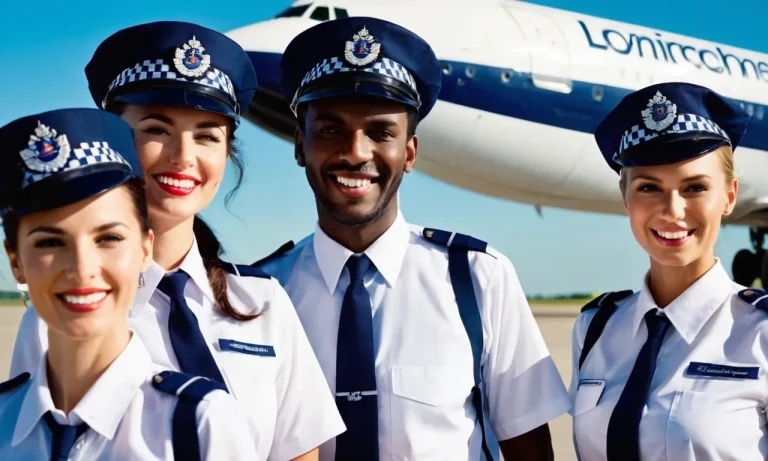Can A 400 Pound Person Fit In An Airline Seat?
Being overweight can make air travel uncomfortable. If you weigh 400 pounds, will you be able to fit into a standard airline seat? Read on as we dive into the details.
If you’re short on time, here’s a quick answer: Most 400 pound people cannot comfortably or safely fit into a standard airline seat.
In this comprehensive guide, we will look at airline seat dimensions, weight limits, and safety issues. We’ll also provide tips for obese travelers to make their flights more bearable.
Airline Seat Dimensions
Standard Coach Seats
When it comes to airline seat dimensions, it’s important to acknowledge that there is significant variation among different airlines and aircraft models. However, most standard coach seats have certain dimensions that are relatively consistent across the industry.
Typically, the width of a standard coach seat ranges from 17 to 18.5 inches, while the pitch (the distance from one point on a seat to the same point on the seat in front or behind) usually ranges from 28 to 34 inches.
While these dimensions may be suitable for the average-sized passenger, they can pose a challenge for individuals who are larger in size. For a 400-pound person, fitting comfortably into a standard coach seat can be a real concern.
The narrow width and limited legroom can make it difficult to find a comfortable position during a flight.
It’s worth noting that certain airlines offer wider seats or additional legroom for a fee. These options can provide some relief for individuals who require more space. However, it’s important to check with the specific airline regarding their policies and seat dimensions before making any arrangements.
First and Business Class
If a 400-pound person is concerned about fitting into a standard coach seat, they may find more comfort in first or business class. These premium seating options often offer more spacious seats with wider dimensions and increased legroom.
In first and business class, the seat width can range from 20 to 34 inches, providing significantly more space compared to standard coach seats. The pitch is also typically greater, allowing for more legroom and a more comfortable seating experience.
While first and business class tickets may be more expensive, the added comfort and space can make a significant difference for individuals who require it. It’s important to check with the specific airline for their first and business class seat dimensions and availability.
Airline Policies on Overweight Passengers
When it comes to accommodating overweight passengers, airlines have varying policies and procedures. While it is true that a 400-pound person may face some challenges when it comes to fitting in an airline seat, it is important to note that different airlines have different guidelines in place to address this issue.
Seat Size and Comfort
Most airlines have a standard seat size and are designed to accommodate passengers within a certain weight and size range. However, some airlines offer larger seats or provide the option to purchase an extra seat to ensure passenger comfort.
It is advisable for overweight passengers to contact the airline in advance to inquire about seat size options and any additional policies or fees that may apply.
Passenger Safety and Emergency Evacuation
Another factor that airlines consider when it comes to overweight passengers is passenger safety. In the event of an emergency evacuation, it is crucial for all passengers to be able to swiftly exit the aircraft.
Airlines may have weight restrictions in place to ensure that all passengers can safely evacuate the plane if necessary. These restrictions are put in place to comply with safety regulations and should not be interpreted as discriminatory.
Assistance and Accommodations
Airlines strive to provide assistance and accommodations to passengers with specific needs, including those who are overweight. Many airlines have policies in place that allow passengers to request additional assistance or accommodations, such as extra seatbelt extenders or the use of armrests that can be raised to provide more space.
Passengers should reach out to the airline in advance to discuss their specific needs and make necessary arrangements.
Obesity and Discrimination
It is important to mention that discrimination based on weight or size is not acceptable. Airlines should treat all passengers with dignity and respect, regardless of their size. If an overweight passenger feels they have been treated unfairly or discriminated against, they should report the incident to the airline and, if necessary, seek legal advice.
Safety Considerations for Large Passengers
Evacuations
When it comes to safety considerations for large passengers on airplanes, one important aspect to consider is the ability to evacuate the aircraft in case of an emergency. In the event of an evacuation, every second is crucial, and it is essential that all passengers can swiftly exit the aircraft.
For this reason, airlines have specific guidelines in place to ensure the safety of all passengers, including those who may require additional space.
It is important to note that each airline has its own policies and guidelines regarding the accommodation of larger passengers. Some airlines may require individuals who cannot lower the armrests or securely fasten the seatbelt to purchase an additional seat.
This allows for a smoother evacuation process and ensures the safety of everyone on board.
While it may seem inconvenient for larger passengers to purchase an extra seat, it is crucial to prioritize safety above all else. By doing so, airlines can guarantee that all passengers, regardless of their size, have an equal chance of safely evacuating the aircraft in case of an emergency.
Health Risks
Another important consideration when it comes to large passengers is their health risks during a flight. Obesity can be associated with various health conditions such as diabetes, cardiovascular diseases, and respiratory problems.
These conditions may pose additional challenges when flying, requiring individuals to take certain precautions.
It is advisable for larger passengers to consult with their healthcare providers before traveling by air. They can provide guidance on managing any potential health risks and offer recommendations for a comfortable journey.
Additionally, airlines often provide special assistance to passengers with specific needs, including those who require extra space due to their size. Passengers can reach out to the airline in advance to inquire about any available accommodations.
Furthermore, it is important to note that airlines are continually working to improve the comfort and safety of all passengers, regardless of their size. Some airlines offer wider seats or seating arrangements that can better accommodate larger individuals.
These measures aim to ensure a pleasant and safe travel experience for everyone on board.
Tips for Obese Travelers
Purchase Additional Seats
For obese travelers who may find it uncomfortable or impossible to fit in a standard airline seat, purchasing an additional seat can be a great solution. This not only ensures more space and comfort during the flight but also avoids encroaching on the personal space of neighboring passengers.
Many airlines offer discounted rates for purchasing an extra seat, so it’s worth checking with the airline beforehand. It’s always better to have extra space and enjoy a stress-free journey.
Request a Seat Belt Extender
Another important tip for obese travelers is to request a seat belt extender. These extenders are designed to provide a longer seat belt that can comfortably fit around larger bodies. Simply ask a flight attendant for a seat belt extender when you board the plane, and they will be happy to assist you.
It’s important to ensure that the seat belt fits properly and securely, as safety should always be a top priority during air travel.
Consider Comfortable Clothing
When traveling as an obese person, it’s essential to wear comfortable clothing. Opt for loose-fitting and breathable fabrics that allow for easy movement and provide maximum comfort throughout the journey. Avoid wearing tight or restrictive clothing that can make the flight even more uncomfortable.
Additionally, consider wearing layers, as temperatures on planes can vary. This way, you can easily adjust your clothing to suit your comfort level.
Remember, air travel should be a pleasant experience for everyone, regardless of their size. By following these tips, obese travelers can ensure a more comfortable and enjoyable journey.
Conclusion
While most 400 pound people cannot fit safely or comfortably in a standard airline seat, there are steps you can take to improve your flying experience. Being informed about airline policies, seating dimensions, and health risks can help you plan appropriately.
With some advanced preparation and flexibility, air travel is still possible even with obesity.








